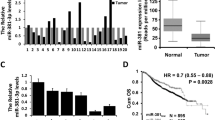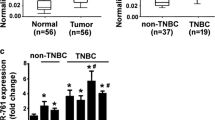Abstract
MicroRNAs (miRNAs) have been demonstrated to play critical roles in the tumorigenesis of triple-negative breast cancer (TNBC). In this work, we addressed the sepecific role of miR-296-3p in TNBC. The levels of miR-296-3p and SOX4 were determined using RT-qPCR. The function of miR-296-3p overexpression on TNBC cell proliferation, migration, invasion, cancer stem cell (CSC)-like proterties, and Wnt pathway activation was investigated by MTT, EdU, wound healing, Transwell, sphere formation assays and western blot. Mechanistic investigations, including luciferase reporter, RNA pull-down, and RIP assays, were conducted to explore the regulatory mechanisms of miR-296-3p. We found that miR-296-3p was downregulated in TNBC tissues and cells. Overexpression of miR-296-3p suppressed TNBC cell proliferation, migration, invasion, and CSC-like proterties. Furthermore, miR-296-3p could bind to SOX4 and negatively modulate SOX4 expression. In addition, miR-296-3p was verified to inhibit Wnt/β-catenin pathway by downregulating SOX4. Moreover, overexpression of SOX4 or activation of Wnt pathway rescued the miR-296-3p upregulation-mediated suppressive effect on cellular processes in TNBC. In conclusion, miR‑296‑3p inhibits Wnt/β-catenin pathway by targeting SOX4 and exerts anti-tumor effects in TNBC.







Similar content being viewed by others
References
Abu-Duhier FM, Javid J, Sughayer MA, Mir R, Albalawi T and Alauddin MS 2018 Clinical significance of circulatory miRNA-21 as an efficient non-invasive biomarker for the screening of lung cancer patients. Asian Pac. J. Cancer Prev. 19 2607–2611
Anastas JN and Moon RT 2013 WNT signalling pathways as therapeutic targets in cancer. Nat. Rev. Cancer 13 11–26
Bai Y, Liao H, Liu T, Zeng X, Xiao F, Luo L, Guo H and Guo L 2013 MiR-296-3p regulates cell growth and multi-drug resistance of human glioblastoma by targeting ether-a-go-go (EAG1). Eur. J. Cancer 49 710–724
Bai X, Han G, Liu Y, Jiang H and He Q 2018 MiRNA-20a-5p promotes the growth of triple-negative breast cancer cells through targeting RUNX3. Biomed. Pharmacother. 103 1482–1489
Bartel DP 2009 MicroRNAs: target recognition and regulatory functions. Cell 136 215–233
Bilir B, Kucuk O and Moreno CS 2013 Wnt signaling blockage inhibits cell proliferation and migration, and induces apoptosis in triple-negative breast cancer cells. J. Transl. Med. 11 280
Butti R, Gunasekaran VP, Kumar TVS, Banerjee P and Kundu GC 2019 Breast cancer stem cells: Biology and therapeutic implications. Int. J. Biochem. Cell Biol. 107 38–52
Calin GA and Croce CM 2006 MicroRNA signatures in human cancers. Nat. Rev. Cancer 6 857–866
Chen W, Zheng R, Baade PD, Zhang S, Zeng H, Bray F, Jemal A, Yu XQ and He J 2016 Cancer statistics in China 2015. CA Cancer J. Clin. 66 115–132
Chu PY, Hou MF, Lai JC, Chen LF and Lin CS 2019 Cell reprogramming in tumorigenesis and its therapeutic implications for breast cancer. Int. J. Mol. Sci. 20 1827
Dawood S 2010 Triple-negative breast cancer: epidemiology and management options. Drugs 70 2247–2258
De La Cruz-Merino L, Palazón-Carrión N, Henao-Carrasco F, Nogales-Fernández E, Álamo-De La Gala M, Vallejo-Benítez A, Chiesa M and Sánchez-Margalet V 2019 New horizons in breast cancer: the promise of immunotherapy. Clin. Transl. Oncol. 21 117–125
Deng X, Liu Z, Liu X, Fu Q, Deng T, Lu J, Liu Y, Liang Z, Jiang Q, Cheng C and Fang W 2018 miR-296-3p negatively regulated by nicotine stimulates cytoplasmic translocation of c-Myc via MK2 to suppress chemotherapy resistance. Mol. Ther. 26 1066–1081
Dey N, Barwick BG, Moreno CS, Ordanic-Kodani M, Chen Z, Oprea-Ilies G, Tang W, Catzavelos C, Kerstann KF, Sledge GW Jr, Abramovitz M, Bouzyk M, De P and Leyland-Jones BR 2013 Wnt signaling in triple negative breast cancer is associated with metastasis. BMC Cancer 13 537
Eyler CE and Rich JN 2008 Survival of the fittest: cancer stem cells in therapeutic resistance and angiogenesis. J. Clin. Oncol. 26 2839–2845
Ge T, Wu HC, Zhou YY, Shen SM, Zhu LG and You GX 2019 MiR-296-3p may affect the proliferation and migration of non-small cell lung cancer cells via regulating RABL3. Eur. Rev. Med. Pharmacol. Sci. 23 5823–5830
Ghoncheh M, Pournamdar Z and Salehiniya H 2016 Incidence and mortality and epidemiology of breast cancer in the world. Asian Pac. J. Cancer Prev. 17 43–46
Gooding AJ, Zhang B, Gunawardane L, Beard A, Valadkhan S and Schiemann WP 2019 The lncRNA BORG facilitates the survival and chemoresistance of triple-negative breast cancers. Oncogene 38 2020–2041
Hong T, Ding J and Li W 2019 miR-7 reverses breast cancer resistance to chemotherapy by targeting MRP1 And BCL2. Onco. Targets Ther. 12 11097–11105
Iorio MV, Ferracin M, Liu CG, et al. 2005 MicroRNA gene expression deregulation in human breast cancer. Cancer Res. 65 7065–7070
Jang GB, Kim JY, Cho SD, Park KS, Jung JY, Lee HY, Hong IS and Nam JS 2015 Blockade of Wnt/β-catenin signaling suppresses breast cancer metastasis by inhibiting CSC-like phenotype. Sci Rep 5 12465
Kabakov A, Yakimova A and Matchuk O 2020 Molecular chaperones in cancer stem cells: determinants of stemness and potential targets for antitumor therapy. Cells
Key TJ, Verkasalo PK and Banks E 2001 Epidemiology of breast cancer. Lancet Oncol. 2 133–140
Khramtsov AI, Khramtsova GF, Tretiakova M, Huo D, Olopade OI and Goss KH 2010 Wnt/beta-catenin pathway activation is enriched in basal-like breast cancers and predicts poor outcome. Am. J. Pathol. 176 2911–2920
Lee AK, Ahn SG, Yoon JH and Kim SA 2011 Sox4 stimulates ß-catenin activity through induction of CK2. Oncol. Rep. 25 559–565
Liu X, Chen Q, Yan J, Wang Y, Zhu C, Chen C, Zhao X, Xu M, Sun Q, Deng R, Zhang H, Qu Y, Huang J, Jiang B and Yu J 2013 MiRNA-296-3p-ICAM-1 axis promotes metastasis of prostate cancer by possible enhancing survival of natural killer cell-resistant circulating tumour cells. Cell Death Dis. 4 e928
Porzycki P, Ciszkowicz E, Semik M and Tyrka M 2018 Combination of three miRNA (miR-141, miR-21, and miR-375) as potential diagnostic tool for prostate cancer recognition. Int. Urol. Nephrol. 50 1619–1626
Rafehi H, Orlowski C, Georgiadis GT, Ververis K, El-Osta A and Karagiannis TC 2011 Clonogenic assay: adherent cells. J. vis. Exp.
Scharer CD, Mccabe CD, Ali-Seyed M, Berger MF, Bulyk ML and Moreno CS 2009 Genome-wide promoter analysis of the SOX4 transcriptional network in prostate cancer cells. Cancer Res. 69 709–717
Shi Y, Gong W, Lu L, Wang Y and Ren J 2019 Upregulation of miR-129-5p increases the sensitivity to Taxol through inhibiting HMGB1-mediated cell autophagy in breast cancer MCF-7 cells. Braz. J. Med. Biol. Res. 52 e8657
Sun WM, Tao W, Li JC, Zhu DM and Miao Y 2019 MicroRNA-296 functions as a tumor suppressor in breast cancer by targeting FGFR1 and regulating the Wnt/β-catenin signaling pathway. Eur. Rev. Med. Pharmacol. Sci. 23 10422–10432
Svoronos AA, Engelman DM and Slack FJ 2016 OncomiR or tumor suppressor? The duplicity of MicroRNAs in cancer. Cancer Res. 76 3666–3670
Tang Z, Kang B, Li C, Chen T and Zhang Z 2019 GEPIA2: an enhanced web server for large-scale expression profiling and interactive analysis. Nucleic Acids Res. 47 W556–W560
Telli ML and Sledge GW 2015 The future of breast cancer systemic therapy: the next 10 years. J. Mol. Med. 93 119–125
Torre LA, Bray F, Siegel RL, Ferlay J, Lortet-Tieulent J and Jemal A 2015 Global cancer statistics 2012. CA Cancer J. Clin. 65 87–108
Visvader JE and Lindeman GJ 2008 Cancer stem cells in solid tumours: accumulating evidence and unresolved questions. Nat. Rev. Cancer 8 755–768
Wang R, Sun Q, Wang P, Liu M, Xiong S, Luo J, Huang H, Du Q, Geller DA and Cheng B 2016 Notch and Wnt/β-catenin signaling pathway play important roles in activating liver cancer stem cells. Oncotarget 7 5754–5768
Wang C, Xu C, Niu R, Hu G, Gu Z and Zhuang Z 2019a MiR-890 inhibits proliferation and invasion and induces apoptosis in triple-negative breast cancer cells by targeting CD147. BMC Cancer 19 577
Wang L, Chen R and Zhang Y 2019b miR-296-3p targets APEX1 to suppress cell migration and invasion of non-small-cell lung cancer. Oncol. Lett. 18 2612–2618
Woodward WA, Chen MS, Behbod F, Alfaro MP, Buchholz TA and Rosen JM 2007 WNT/beta-catenin mediates radiation resistance of mouse mammary progenitor cells. Proc. Natl. Acad. Sci. USA 104 618–623
Xue D, Wang H, Chen Y, Shen D, Lu J, Wang M, Zebibula A, Xu L, Wu H, Li G and Xia L 2019 Circ-AKT3 inhibits clear cell renal cell carcinoma metastasis via altering miR-296-3p/E-cadherin signals. Mol. Cancer 18 151
Zhang J, Liang Q, Lei Y, Yao M, Li L, Gao X, Feng J, Zhang Y, Gao H, Liu DX, Lu J and Huang B 2012a SOX4 induces epithelial-mesenchymal transition and contributes to breast cancer progression. Cancer Res. 72 4597–4608
Zhang H, Zhang X, Wu X, Li W, Su P, Cheng H, Xiang L, Gao P and Zhou G 2012b Interference of Frizzled 1 (FZD1) reverses multidrug resistance in breast cancer cells through the Wnt/β-catenin pathway. Cancer Lett. 323 106–113
Zhang J, Chai S and Ruan X 2020 SOX4 Serves an oncogenic role in the tumourigenesis of human breast adenocarcinoma by promoting cell proliferation, migration and inhibiting apoptosis. Recent Pat. Anticancer Drug Discov. 15 49–58
Author information
Authors and Affiliations
Corresponding author
Additional information
Communicated by Sorab Dalal.
Corresponding editor: Sorab Dalal
Rights and permissions
About this article
Cite this article
Tian, D., Luo, L., Wang, T. et al. MiR-296-3p inhibits cell proliferation by the SOX4-Wnt/β-catenin pathway in triple-negative breast cancer. J Biosci 46, 98 (2021). https://doi.org/10.1007/s12038-021-00219-6
Received:
Accepted:
Published:
DOI: https://doi.org/10.1007/s12038-021-00219-6




